I decided that I had four alternatives:
But I only listed three. No way was I going to hurt my back, not use the boat, or sell it. The unstated fourth option was what most folks recommended—a trailer.
I didn't want one of the longitudinal bunk trailers that are used for motor boats and jet skis, on which you would carry a canoe right side-up, and which are very prevalent on the used market. I wanted a trailer with two horizontal crossbars, with which to carry and store a canoe upside down. New, these trailers cost anywhere from $1,800 to $4,000, maybe plus tax and shipping, and you have to put most of them together from 60+ parts. Yikes!
I could only find three acceptable used crossbar canoe/kayak trailers within a 250 mile radius of me. Thankfully, there was one only three years old, used only three times, all put together, only 60 miles away, and at a very reasonable price. It's a Trailex SUT-250-M2, and here are two of the seller's photos:
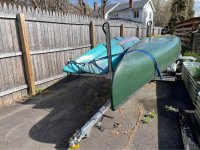
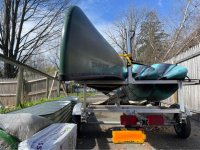
Fate was beckoning me, I thought . . . so I bought it.
I didn't need the vertical uprights, so I removed them in order to position my Morris centrally on the crossbars.
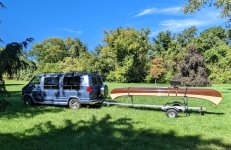
I also had to buy a new portage cart to move the canoe in and out of the garage, and around boat ramp put-ins, because my 16" bicycle wheel cart (Swedish boat cart, Canadian walker) is too high and the tires always go flat in about two weeks. It took a few tries to get the right cart because the canoe's full keel interfered with most cart's horizontal cross members. I had to find one with a deep enough V cross member. Suspenz makes a couple, albeit expensive, so I bought one that works both as an end cart and central cart.
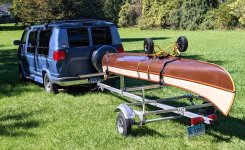
Driving with the wheels on top of the canoe seemed like a convenient idea until I started going along bumpy roads with potholes. The wheels began to slip and slide, so that was the quick end of that experiment.
By the way, three of the four ends of the Thule racks on top of my van have retractable 20" extensions in them. This allows you to half-lift the canoe up to the front bar extension, and then to lift the other end of the canoe onto the back bar extension. However, as I stated, I could not half-lift this canoe up 7 feet because of the combination of my loss of strength and the extreme imbalance of the upside-down canoe when on its very high, pointy nose prow.
The cross-bars of the trailer have cushioned rubber tops, and I positioned the movable U-bolt tie downs so a centralized canoe cannot move left or right.
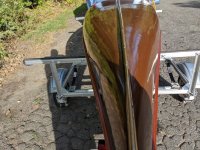
You perhaps can see this better with the straps on.
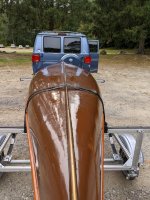
I am still incompetent in backing up the trailer at put-ins. Fortunately, the trailer is so light (about 135 lbs.) that, even with the canoe on it, I can just lift the back end entirely off the ground and swing the trailer in the right direction. When I get close enough to the water . . .
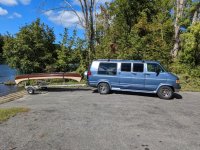
. . . I can either lift the canoe off the crossbars by one gunwale and dangle-carry it into the water; or I can first flip the canoe right side-up on the 72" cross bars and simply push the canoe backwards on its keel right into the water without it hitting the ground at all, and then move it over away from the trailer.
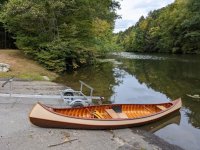
To get the canoe onto the trailer, I just attach the wheels near the end of the canoe. Of course when I'm loading from the water, I have to wade in a few feet and buckle on the cam straps.
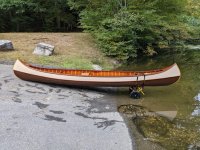
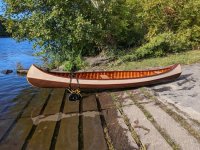
I then wheel the canoe next to the trailer and lift the un-wheeled end onto one of the crossbars.
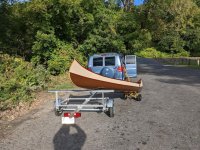
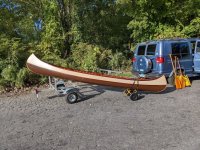
Next, I lift the wheeled end onto the other crossbar.
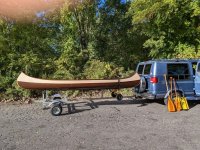
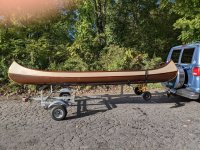
Finally, I remove the wheels, flip the canoe upside down, center it, and strap it up. Aside from the trailer back-up maneuvering, this canoe loading and unloading process is actually easier than my 40 years of piling canoes 7' up on top of full-size conversion vans, for which I've always need a step ladder, a lot of high-altitude strap flipping, and front and rear tie down ropes—none of which is necessary with the trailer.
The old guy is successfully back in the wood-canvas saddle!
My next thread will be a review of how the Morris performed on its first three outings.
 one misstep slinging a 70 pound canoe around can screw your back up. Then you'd be in a world of hurt. I like being on the water instead of being laid up with a bad back.
one misstep slinging a 70 pound canoe around can screw your back up. Then you'd be in a world of hurt. I like being on the water instead of being laid up with a bad back.
 one misstep slinging a 70 pound canoe around can screw your back up. Then you'd be in a world of hurt. I like being on the water instead of being laid up with a bad back.
one misstep slinging a 70 pound canoe around can screw your back up. Then you'd be in a world of hurt. I like being on the water instead of being laid up with a bad back.














